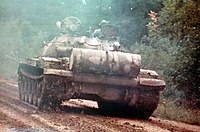로컬 버블
Local Bubble| 슈퍼버블 | |
|---|---|
 국부 거품의 표면에 일부 별 형성 영역이 있는 표현 | |
| 관찰 데이터 | |
| 거리 | 0시간 (0pc) |
| 물리적 특성 | |
| 반지름 | 150 리 |
| 지정 | 국부적 핫 버블, LHB,[1] 국부적 버블, 국부적 성간[2] 버블 |
국부 거품 또는 국부 [3]공동은 우리 은하에 있는 오리온 팔의 성간 매체(ISM)에 있는 상대적 공동입니다.이 성단에는 가장 가까운 천체의 이웃들 중 가장 가까운 것, 그 중에서도 국부성간 구름(태양계를 포함), 인접한 G-구름, 큰곰자리 이동성단(가장 가까운 항성 이동성단), 히아데스 성단(가장 가까운 산개성단)이 포함되어 있습니다.이 성운의 지름은 최소 300광년이며, 중성 수소 밀도는 약 0.05원자3/cm이며, 이는 은하수 ISM 평균(0.5원자3/cm)의 약 10분의 1이며 국부성간운(0.3원자/cm3)[dubious ][4]의 6분의 1이다.
국부 거품의 예외적으로 희박한 가스는 지난 1000만 년에서 2000만 년 사이에 폭발한 초신성의 결과입니다.제미니자리에 있는 펄서인 제밍가는 한때 국부 거품을 만든 단일 초신성의 잔해로 생각되었지만, 이제 플레이아데스 이동 그룹의 하위 그룹 B1에 있는 여러 개의 초신성이 원인이 [5]되어 [6]슈퍼헬의 잔해가 되었다.
묘사
태양계는 지난 5백만 [7]년에서 1천만 년 동안 국지성 거품이 현재 차지하고 있는 지역을 여행해 왔다.현재 위치는 거품 내 밀도가 높은 물질의 소영역인 국부성간운(LIC)에 있습니다.LIC는 Local Bubble과 Loop I Bubble이 만나는 곳에서 형성되었습니다.LIC 내의 가스는 입방 센티미터 당 약 0.3 원자의 밀도를 가지고 있습니다.
국부 거품은 구형은 아니지만 은하면이 더 좁아져 달걀 모양이나 타원형으로 변하며 은하면 위아래로 넓어져 모래시계 모양으로 변합니다.이것은 특히 루프 I 버블을 포함하여 밀도가 낮은 성간 매질(ISM)의 다른 버블과 맞닿아 있습니다.루프 I 거품은 태양으로부터 약 500광년 떨어진 전갈자리-센타우루스 성협의 초신성과 항성풍에 의해 제거되고 가열되어 유지되었다.루프 I 거품에는 오른쪽 위의 다이어그램에 표시된 것처럼 안타레스 별(α Sco 또는 전갈자리 알파라고도 함)이 포함되어 있습니다.여러 개의 터널이 국부 버블의 캐비티를 루프 I 버블(루퍼스 터널)[8]과 연결합니다.국부 버블에 인접한 다른 버블로는 루프 II 버블과 루프 III 버블이 있습니다.2019년, 연구원들은 국부성간 구름과 관련이 있는 국부성간 철을 남극에서 발견했습니다. 이것은 국부성간 [9]구름의 형성과 관련이 있을 수 있습니다.
관찰
2003년 2월에 발사되어 2008년 4월까지 활동한 작은 우주 관측소인 Cosmic Hot Interstell Plasma Spectrometer (CHIPS 또는 CHIPSat)는 국부 [10]거품 내의 뜨거운 가스를 조사했다.국부 거품은 또한 버블 내의 뜨거운 EUV 선원을 조사했던 Extreme Ultra Ultrain Explorer 임무(1992-2001)의 관심 영역이었다.버블의 가장자리 너머의 근원은 확인되었지만 밀도가 높은 성간 매체에 의해 감쇠되었다.2019년, 확산성간 [11]띠의 관측을 이용하여 국부 거품의 첫 3D 지도가 보고되었다.
별의 형성에 미치는 영향
2022년 1월, 네이처 저널에 실린 논문은 거품 팽창 표면의 작용이 가스와 파편을 모아 인근 젊은 [12]별의 형성에 기여한다는 것을 관측과 모델링으로 밝혀냈다.
이 새로운 별들은 전형적으로 황소자리 분자 구름이나 산개성단 플레이아데스 같은 분자 구름 안에 있습니다.
갤러리
「 」를 참조해 주세요.
레퍼런스
- ^ Egger, Roland J.; Aschenbach, Bernd (February 1995). "Interaction of the Loop I supershell with the Local Hot Bubble". Astronomy and Astrophysics. 294 (2): L25–L28. arXiv:astro-ph/9412086. Bibcode:1995A&A...294L..25E.
- ^ "NAME Local Bubble". SIMBAD. Centre de données astronomiques de Strasbourg. Retrieved 15 March 2014.
- ^ Abt, Helmut A. (December 2015). "Hot gaseous stellar disks avoid regions of low interstellar densities". Publications of the Astronomical Society of the Pacific. 127 (958): 1218–1225. Bibcode:2015PASP..127.1218A. doi:10.1086/684436.
- ^ "Our local galactic neighborhood". Interstellar.jpl.nasa.gov. National Aeronautics and Space Administration (NASA). 8 February 2000. Archived from the original on 21 November 2013. Retrieved 23 July 2013.
- ^ Berghoefer, T.W.; Breitschwerdt, D. (2002). "The origin of the young stellar population in the solar neighborhood – a link to the formation of the Local Bubble?". Astronomy and Astrophysics. 390 (1): 299–306. arXiv:astro-ph/0205128v2. Bibcode:2002A&A...390..299B. doi:10.1051/0004-6361:20020627. S2CID 6002327.
- ^ Gabel, J.R.; Bruhweiler, F.C. (8 January 1998). "[51.09] Model of an expanding supershell structure in the LISM". American Astronomical Society. Archived from the original on 15 March 2014. Retrieved 14 March 2014.
- ^ "Local Chimney and Superbubbles". Solstation.com.
- ^ Lallement, R.; Welsh, B.Y.; Vergely, J.L.; Crifo, F.; Sfeir, D. (2003). "3D mapping of the dense interstellar gas around the Local Bubble". Astronomy and Astrophysics. 411 (3): 447–464. Bibcode:2003A&A...411..447L. doi:10.1051/0004-6361:20031214.
- ^ Koll, D.; et al. (2019). "Interstellar 60Fe in Antarctica". Physical Review Letters. 123 (7): 072701. Bibcode:2019PhRvL.123g2701K. doi:10.1103/PhysRevLett.123.072701. PMID 31491090. S2CID 201868513.
- ^ "Cosmic Hot Interstellar Plasma Spectrometer (CHIPS)". Chips.ssl.berkeley.edu. University of California – Berkeley. 12 January 2003. Archived from the original on 21 November 2013. Retrieved 23 July 2013.
- ^ Farhang, Amin; van Loon, Jacco Th.; Khosroshahi, Habib G.; Javadi, Atefeh; Bailey, Mandy (8 July 2019). "3D map of the local bubble". Nature Astronomy (letter). 3: 922–927. arXiv:1907.07429. doi:10.1038/s41550-019-0814-z. S2CID 197402894.
- ^ "Star Formation near the Sun is driven by expansion of the Local Bubble". The Local Bubble. Retrieved 7 February 2022.
{{cite web}}: CS1 maint :url-status (링크) - ^ a b Zucker, Catherine; Goodman, Alyssa A.; Alves, João; Bialy, Shmuel; Foley, Michael; Speagle, Joshua S.; Großschedl, Josefa; Finkbeiner, Douglas P.; Burkert, Andreas; Khimey, Diana; Swiggum, Cameren (12 January 2022). "Star formation near the Sun is driven by expansion of the Local Bubble". Nature: 1–4. arXiv:2201.05124. doi:10.1038/s41586-021-04286-5. ISSN 1476-4687.
- ^ a b "1,000-Light-Year Wide Bubble Surrounding Earth is Source of All Nearby, Young Stars Center for Astrophysics". www.cfa.harvard.edu. Retrieved 17 January 2022.
- ^ Pelgrims, Vincent; Ferriere, Katia; Boulanger, Francois; Lallement, Rosine; Montier, Ludovic (17 February 2020). "Modeling the magnetized Local Bubble from dust data". Astronomy & Astrophysics. arXiv:1911.09691. doi:10.1051/0004-6361/201937157.
추가 정보
- Anderson, Mark (6 January 2007). "Don't stop till you get to the Fluff". New Scientist. 193 (2585): 26–30. doi:10.1016/S0262-4079(07)60043-8. Retrieved 5 September 2020.
{{cite journal}}: CS1 maint :url-status (링크) - Lallement, R.; Welsh, B.Y.; Vergely, J.L.; Crifo, F.; Sfeir, D. (1 December 2003). "3D mapping of the dense interstellar gas around the Local Bubble". Astronomy & Astrophysics. 411 (3): 447–464. Bibcode:2003A&A...411..447L. doi:10.1051/0004-6361:20031214.
- "Near-Earth supernovas". Science@NASA Headline News. NASA. 6 January 2003.
- "A breeze from the stars". Science@NASA Headline News. NASA. 17 December 2004.
외부 링크
 Wikimedia Commons의 로컬 버블 관련 미디어
Wikimedia Commons의 로컬 버블 관련 미디어- "A 3D map of the Milky Way galaxy and the Orion Arm". 3dgalaxymap.com.










